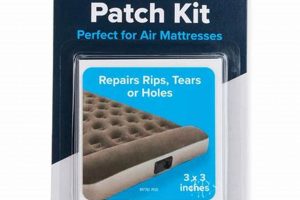Achieving the desired firmness in an Intex air mattress necessitates understanding inflation methods and the equipment required. This process generally involves introducing air into the mattress’s internal chambers until the mattress reaches its intended structural stability and comfort level. Utilizing appropriate pumps and understanding valve mechanisms are key factors in successful inflation.
Proper inflation is essential for achieving a comfortable and supportive sleep surface. A fully inflated mattress provides adequate spinal alignment and minimizes pressure points, contributing to a more restful sleep experience. Conversely, an under-inflated mattress may lack sufficient support, leading to discomfort and potential back strain. Throughout the evolution of inflatable bedding, convenience and portability have remained central to their appeal, making correct inflation practices even more critical.
The following sections will detail various methods for achieving optimal inflation, including manual and electric pump options, and provide guidance on troubleshooting common inflation-related issues. Attention will also be given to understanding valve types and compatibility with different inflation devices.
Inflation Guidance
The following guidelines facilitate efficient and effective inflation of Intex air mattresses, ensuring optimal performance and longevity.
Tip 1: Valve Inspection: Prior to initiating inflation, thoroughly inspect the mattress valve for any signs of damage or debris. A compromised valve can lead to air leakage and prevent complete inflation.
Tip 2: Pump Compatibility: Ensure compatibility between the chosen pump type and the mattress valve. Using an incompatible nozzle can damage the valve or result in ineffective inflation. Adapters may be necessary.
Tip 3: Controlled Inflation: Avoid over-inflation, which can stress the seams and potentially lead to rupture. Inflate the mattress gradually, periodically checking firmness to achieve the desired level of support.
Tip 4: Ambient Temperature Considerations: Air pressure within the mattress will fluctuate with temperature changes. During colder temperatures, the mattress may appear deflated; conversely, warmer temperatures can cause over-expansion. Adjust air pressure accordingly.
Tip 5: Surface Preparation: Before inflating, ensure the mattress is placed on a smooth, clean surface free from sharp objects. This minimizes the risk of punctures or tears during inflation and use.
Tip 6: Gradual Deflation: When deflating the mattress, open the valve fully and allow air to escape naturally. Applying excessive pressure to expedite deflation can damage internal structures.
Following these guidelines contributes to extended product lifespan and enhanced user experience. Attention to detail throughout the inflation and deflation processes ensures consistent performance.
The subsequent sections will address potential issues encountered during the inflation process and provide troubleshooting strategies for their resolution.
1. Pump Compatibility
Pump compatibility forms a foundational element in the successful inflation of Intex air mattresses. Selecting a suitable pump is not merely a matter of convenience but is critical for ensuring effective and safe inflation. A mismatch between the pump and the mattress valve can lead to inefficient air transfer, valve damage, or complete inability to inflate the mattress.
- Valve Type Matching
Intex air mattresses utilize various valve designs, including Boston valves, double-lock valves, and standard pinch valves. Each valve type requires a specific nozzle or adapter for a secure connection. Attempting to use a pump with an incompatible nozzle will result in air leakage and prevent proper inflation. Identifying the valve type and matching it with the appropriate pump nozzle is the first step towards successful inflation.
- Pump Power and Capacity
Pumps vary significantly in their power output and air displacement capacity. Smaller hand pumps or foot pumps, while portable, may require considerable effort and time to fully inflate a larger air mattress. Conversely, high-volume electric pumps can rapidly inflate the mattress but may require a power source and careful monitoring to prevent over-inflation. Selecting a pump with adequate power and capacity relative to the mattress size is essential for efficient inflation.
- Adapter Utilization
Universal pump kits often include a range of adapters designed to accommodate different valve types and sizes. These adapters bridge the gap between the pump nozzle and the mattress valve, creating a secure and airtight connection. Utilizing the correct adapter is crucial for preventing air leakage and ensuring effective inflation. A missing or improperly fitted adapter can render even a powerful pump ineffective.
- Inflation Pressure Control
Certain electric pumps feature pressure monitoring systems that allow users to pre-set the desired inflation level. This feature helps prevent over-inflation, which can damage the mattress seams and compromise its structural integrity. Pumps without pressure control require careful manual monitoring of the mattress firmness during inflation to avoid exceeding the recommended pressure limits. Understanding the pump’s capabilities and limitations is paramount for safe and effective inflation.
In summary, pump compatibility extends beyond simple connection; it encompasses valve type matching, power adequacy, adapter utilization, and pressure control. Failure to address these aspects can result in inefficient inflation, valve damage, or compromised mattress performance. Therefore, meticulous attention to pump compatibility is vital for anyone seeking to achieve optimal comfort and longevity from their Intex air mattress.
2. Valve Integrity
Valve integrity is paramount to successful inflation and sustained performance of an Intex air mattress. The valve serves as the primary portal for air entry and retention, directly influencing the mattress’s ability to achieve and maintain the desired firmness. Compromised valve integrity can negate even the most diligent inflation efforts.
- Airtight Seal Maintenance
The valve’s primary function is to create an airtight seal, preventing air leakage once the mattress is inflated. This seal is maintained through a combination of physical design and material properties. Damage to the valve’s sealing surfaces, such as cracks, tears, or debris accumulation, can compromise the seal, leading to gradual deflation. Regular inspection and cleaning are crucial for preserving this airtight seal and ensuring consistent inflation levels.
- Valve Materia
l DurabilityAir mattress valves are typically constructed from durable polymers designed to withstand repeated use and exposure to varying temperatures and pressures. However, prolonged exposure to sunlight, harsh chemicals, or excessive force can degrade the valve material, leading to brittleness, cracking, or deformation. Such material degradation directly impacts the valve’s ability to maintain a tight seal and retain air pressure. Selecting mattresses with high-quality valve materials and implementing appropriate storage practices can mitigate this risk.
- Valve Mechanism Functionality
Many Intex air mattresses incorporate sophisticated valve mechanisms, such as double-lock or Boston valves, to enhance air retention and prevent accidental deflation. These mechanisms rely on intricate internal components that must function correctly to ensure proper sealing. Damage or malfunction of these internal components can compromise the valve’s ability to seal effectively, resulting in air leakage. Understanding the specific valve mechanism and adhering to manufacturer’s instructions for operation and maintenance are essential for preserving valve functionality.
- Compatibility with Inflation Devices
The valve must be compatible with the chosen inflation device to ensure a secure and airtight connection. Using an incompatible nozzle or adapter can damage the valve threads or sealing surfaces, leading to air leakage. Selecting the correct nozzle or adapter is crucial for preventing valve damage and achieving optimal inflation. Universal pump kits often include a range of adapters designed to accommodate different valve types, but careful selection and proper installation are essential.
In summary, valve integrity is a multifaceted aspect that encompasses airtight seal maintenance, material durability, mechanism functionality, and compatibility with inflation devices. Addressing these elements is crucial for ensuring successful and sustained inflation of Intex air mattresses, contributing to enhanced comfort and product longevity. Regular inspection, proper maintenance, and careful selection of inflation equipment are key strategies for preserving valve integrity and optimizing mattress performance.
3. Inflation Pressure
Inflation pressure represents a critical parameter in the process of inflating an Intex air mattress, directly affecting the mattress’s comfort, support, and overall structural integrity. Proper management of inflation pressure is therefore integral to the successful use of these products.
- Optimal Firmness and Support
The primary function of inflation pressure is to provide the necessary firmness and support for the user. Insufficient pressure results in a soft, sagging mattress that fails to adequately support the spine, potentially leading to discomfort or back pain. Conversely, excessive pressure can create an overly rigid surface, diminishing comfort and increasing the risk of seam damage. Achieving the optimal pressure balance is essential for maximizing both comfort and support. Consider a mattress used for camping; under-inflation leaves the user vulnerable to the uneven ground, while over-inflation creates a hard, unforgiving surface. Finding the ideal pressure ensures a comfortable night’s sleep.
- Temperature Sensitivity and Pressure Fluctuation
Air pressure within an enclosed space, such as an air mattress, is directly influenced by temperature. As temperature increases, air expands, leading to increased pressure; conversely, decreasing temperature causes air to contract, resulting in reduced pressure. This phenomenon necessitates careful monitoring and adjustment of inflation pressure to compensate for temperature-induced fluctuations. A mattress inflated indoors at room temperature and then moved outdoors on a cold night will experience a pressure drop, requiring additional inflation to maintain the desired firmness. Ignoring this temperature sensitivity can lead to discomfort or mattress damage.
- Seam Stress and Structural Integrity
Excessive inflation pressure places undue stress on the mattress seams and internal structures. Over time, this stress can lead to seam failure, material fatigue, and ultimately, mattress rupture. Maintaining inflation pressure within the manufacturer’s recommended range is crucial for preserving the mattress’s structural integrity and extending its lifespan. Consider an air mattress used frequently and consistently inflated to its maximum capacity; the constant stress on the seams will eventually lead to leaks and failure. Adhering to recommended pressure limits minimizes this risk.
- Valve Performance and Air Retention
The integrity of the air mattress valve is directly linked to inflation pressure. Excessive pressure can damage the valve’s sealing mechanism, leading to gradual air leakage and requiring frequent re-inflation. Conversely, insufficient pressure may not fully engage the valve’s sealing mechanism, also resulting in air leakage. Maintaining the appropriate pressure balance is essential for optimizing valve performance and ensuring long-term air retention. A valve subjected to constant over-inflation will eventually fail, leading to a mattress that cannot hold air. Careful pressure management preserves valve functionality and air retention.
In essence, inflation pressure is a critical control variable in the context of air mattress use. Managing it correctly, in accordance with temperature considerations and the manufacturer’s guidelines, not only optimizes comfort and support but also safeguards the mattress’s structural integrity and extends its lifespan. Understanding the interplay between pressure, temperature, and material properties is therefore crucial for anyone using these products.
4. Temperature Impact
Temperature exerts a significant influence on the inflation dynamics of Intex air mattresses, directly impacting air pressure and overall performance. Understanding these thermal effects is essential for achieving and maintaining optimal comfort and support.
- Air Volume Fluctuation
According to Charles’s Law, the volume of a gas is directly proportional to its absolute temperature, assuming constant pressure and mass. In the context of an air mattress, as temperature increases, the air inside expands, raising the internal pressure. Conversely, a decrease in temperature causes the air to contract, reducing pressure. This phenomenon necessitates adjusting the air volume to compensate for temperature changes. For example, an air mattress inflated indoors at 22C (72F) and subsequently exposed to outdoor temperatures of 10C (50F) will experience a noticeable pressure drop, requiring additional air to maintain the initial firmness. Conversely, moving a mattress from a cold environment to a warm one will result in increased pressure, potentially leading to over-inflation and seam stress. Failing to account for these temperature-induced volume fluctuations can compromise comfort and mattress integrity.
- Material Elasticity and Conformity
Temperature affects the elasticity of the materials used in air mattress construction, primarily PVC. At lower temperatures, PVC becomes less flexible and more rigid, affecting its ability to conform to body contours. This can result in a less comfortable sleep
surface. Conversely, higher temperatures can increase the material’s flexibility, potentially leading to excessive stretching and reduced support. A mattress stored in a cold environment before inflation will initially exhibit a stiffer feel, requiring a longer period to conform to the user’s body. Over time, the material will soften, but this initial rigidity can impact immediate comfort levels. Therefore, allowing the mattress to equilibrate to room temperature before inflation is recommended to optimize material elasticity and conformity. - Pressure Gauge Accuracy
The accuracy of pressure gauges used to measure air mattress inflation can be affected by ambient temperature. Most pressure gauges are calibrated for specific temperature ranges, and deviations from these ranges can introduce measurement errors. While this impact is more pertinent for gauges used for tires, it is less important for mattress in daily usages. This can result in either under- or over-inflation if the gauge readings are not properly adjusted for temperature variations. Using a pressure gauge in extremely cold or hot conditions can lead to inaccurate readings, prompting incorrect inflation adjustments. Therefore, it is advisable to use pressure gauges at or near their calibrated temperature range or to account for temperature-induced errors in readings. Calibrating the gauge or understanding its temperature sensitivity enhances the accuracy of inflation pressure management.
- Seam Integrity and Thermal Stress
Significant temperature variations can induce thermal stress on air mattress seams. Rapid temperature changes cause the mattress materials to expand and contract at different rates, placing stress on the bonded seams. Over time, this cyclic stress can weaken the seams, leading to air leaks and reduced mattress lifespan. Consider an air mattress used in environments with large diurnal temperature swings, such as campsites in mountainous regions. The repeated expansion and contraction of the mattress materials due to temperature variations will accelerate seam fatigue and increase the risk of leaks. Protecting the mattress from extreme temperature fluctuations and storing it properly can mitigate thermal stress and preserve seam integrity.
Understanding and managing temperature-related effects are integral to the proper procedure. By considering air volume fluctuation, material elasticity, pressure gauge accuracy, and seam integrity, users can optimize comfort, prolong mattress lifespan, and avoid common inflation-related issues. Adapting inflation practices to account for ambient temperature enhances the overall performance and durability.
5. Surface Preparation
Surface preparation forms a foundational step inextricably linked to the successful inflation and subsequent use of an Intex air mattress. A properly prepared surface mitigates risks associated with punctures, uneven support, and compromised hygiene, contributing directly to the user’s comfort and the mattress’s longevity.
- Debris Removal and Puncture Prevention
The presence of sharp objects, such as small stones, splinters, or debris, on the inflation surface poses a significant threat to the air mattress’s integrity. These objects can easily puncture the PVC material, leading to air leaks and rendering the mattress unusable. Thoroughly inspecting and clearing the intended inflation area is crucial for preventing such damage. Consider, for example, setting up an air mattress on a campsite; neglecting to remove sharp rocks or twigs can result in immediate punctures upon inflation. Similarly, indoor settings may harbor hidden staples, glass shards, or other sharp items. Diligent debris removal is, therefore, an essential preventative measure.
- Level Ground and Even Weight Distribution
Inflating an air mattress on an uneven surface can result in uneven weight distribution, stressing certain areas of the mattress more than others. This uneven stress can lead to premature wear and tear, seam separation, or even rupture. Selecting a level surface ensures that weight is distributed evenly across the entire mattress, minimizing stress concentrations and prolonging the mattress’s lifespan. Imagine inflating an air mattress on a slightly sloped floor; one side will bear more weight, leading to discomfort and potentially damaging the internal structure over time. A level surface promotes even inflation and uniform support.
- Protective Layering and Material Compatibility
Placing a protective layer between the air mattress and the floor can provide additional protection against abrasion, punctures, and dirt accumulation. This layer can consist of a blanket, tarp, or fitted sheet, creating a barrier that shields the mattress from direct contact with the floor surface. Moreover, the protective layer can improve hygiene by preventing the mattress from absorbing dust and allergens from the floor. Consider using a thick blanket under the air mattress when camping on rough terrain; the blanket absorbs minor bumps and prevents direct abrasion against the ground. This extra layer of protection significantly reduces the risk of damage and enhances hygiene.
- Temperature Acclimation and Material Flexibility
Allowing the air mattress to acclimate to the ambient temperature before inflation can improve its flexibility and reduce the risk of cracking or tearing, particularly in cold environments. PVC material becomes more rigid at lower temperatures, making it more susceptible to damage during inflation. Bringing the mattress to room temperature before inflating allows the material to become more pliable and reduces the likelihood of stress-related damage. Storing the mattress in a cold garage and then immediately inflating it can result in increased stress on the seams and material during inflation. Warming the mattress to room temperature before inflation improves its overall flexibility and reduces the risk of cold-related damage.
In summary, surface preparation is not merely a preparatory step but an integral component of the inflation process that directly impacts the air mattress’s structural integrity, user comfort, and lifespan. Addressing debris removal, level ground selection, protective layering, and temperature acclimation ensures optimal inflation and sustained performance. Failing to attend to these surface preparation considerations significantly increases the risk of damage and diminished user experience.
6. Deflation Process
The deflation process represents the inverse operation of inflation, yet it is equally crucial in the proper care and maintenance of an Intex air mattress. While inflation provides the necessary rigidity and support, controlled and complete deflation is essential for storage, transportation, and preventing material degradation. Proper execution of the deflation process directly influences the mattress’s longevity and future usability.
- Valve Mechanism Engagement
The deflation process necessitates the full engagement of the mattress valve mechanism. This typically involves opening the valve completely to allow for maximum airflow. Partial valve opening can significantly impede the deflation rate, prolonging the process and potentially leading to uneven air expulsion. Some valves feature specific deflation settings or mechanisms to facilitate faster air release. Under
standing and properly utilizing the valve mechanism is paramount for efficient deflation. An example is a double-lock valve that requires two distinct actions to fully open for deflation; failing to properly engage both mechanisms will drastically reduce the deflation rate. - External Pressure Application
While the valve mechanism allows for passive air expulsion, applying external pressure to the mattress can significantly accelerate the deflation process. This can be achieved by gently rolling or folding the mattress, forcing air towards the open valve. Applying excessive or uneven pressure, however, can damage internal baffles or seams, compromising the mattress’s structural integrity. The goal is to systematically expel air without inducing undue stress on the mattress materials. Rolling the mattress from the end opposite the valve creates a gradual and controlled expulsion of air, minimizing stress concentrations. This contrasts with folding the mattress abruptly, which can create sharp creases and potential damage.
- Environmental Considerations
The ambient temperature and humidity levels can influence the deflation process. Lower temperatures can decrease the air volume within the mattress, resulting in slower deflation. High humidity can trap moisture within the mattress, potentially leading to mold growth if not properly addressed. Deflating the mattress in a dry, well-ventilated environment is recommended to minimize moisture retention and facilitate faster air expulsion. Deflating a mattress outdoors on a cold, damp day will be significantly slower than deflating it indoors in a warm, dry room. Furthermore, the outdoor deflation may lead to moisture accumulation, requiring subsequent drying.
- Complete Air Removal and Storage Preparation
The ultimate goal of the deflation process is to remove as much air as possible from the mattress, preparing it for compact storage. Residual air can lead to increased bulk and potential material stress during storage. After the initial deflation, carefully folding or rolling the mattress and securing it with straps can further compress it, maximizing air removal. Proper storage in a dry, temperature-controlled environment will then prevent moisture accumulation and material degradation. Simply opening the valve and loosely folding the mattress leaves a significant amount of residual air, increasing storage volume. Conversely, tightly rolling and securing the mattress with straps minimizes volume and protects the material from unnecessary stress.
In summary, the deflation process, while seemingly simple, requires careful attention to valve mechanism engagement, controlled pressure application, environmental considerations, and complete air removal. Proper deflation not only facilitates convenient storage but also preserves the mattress’s integrity and prolongs its lifespan, ensuring its readiness for subsequent inflation and use. Failing to adequately deflate the mattress can lead to storage difficulties, material degradation, and ultimately, a compromised user experience. Thus, deflation is not merely an afterthought but an integral component of the overall lifecycle of an Intex air mattress, intimately connected to “how to inflate an intex air mattress”.
Frequently Asked Questions
This section addresses common inquiries regarding the proper inflation techniques and maintenance procedures for Intex air mattresses, ensuring optimal performance and longevity.
Question 1: What is the correct method for determining the appropriate inflation level?
The appropriate inflation level is achieved when the mattress surface is firm to the touch, allowing minimal sinking when subjected to body weight. Over-inflation risks seam damage, while under-inflation compromises support.
Question 2: Can any type of pump be used to inflate the mattress?
No. Compatibility between the pump nozzle and the mattress valve is essential. Using an incompatible pump can damage the valve or prevent proper inflation. Adapters are recommended when necessary.
Question 3: How does temperature affect the mattresss air pressure?
Air pressure within the mattress fluctuates with temperature changes. Lower temperatures decrease air pressure, potentially requiring additional inflation. Higher temperatures increase pressure, potentially leading to over-inflation.
Question 4: What should be done if the mattress continuously loses air?
Check the valve for proper closure and potential damage. Inspect the mattress surface for punctures or tears. Apply a sealant patch to any identified leaks, following manufacturer instructions.
Question 5: Is it necessary to fully deflate the mattress for storage?
Complete deflation is recommended to minimize storage volume and prevent material stress. Utilize the valve mechanism and external pressure to expel as much air as possible before folding or rolling the mattress.
Question 6: What is the best way to clean an Intex air mattress?
Use a mild soap and water solution with a soft cloth. Avoid harsh chemicals or abrasive cleaners, which can damage the PVC material. Allow the mattress to fully dry before storing.
Proper inflation practices, including attention to pump compatibility, temperature fluctuations, and leak detection, are crucial for maintaining the functionality and lifespan of Intex air mattresses.
The subsequent section will provide specific troubleshooting steps for resolving common inflation-related problems.
Conclusion
The preceding discussion has thoroughly explored various aspects of air mattress inflation, emphasizing techniques, potential issues, and preventative measures. The appropriate execution of these procedures is fundamentally linked to the sustained performance and user satisfaction derived from Intex air mattresses. Adherence to the presented guidelines contributes to the longevity and reliability of these products.
Consistent implementation of these strategies will yield optimal results. Attention to detail, proactive maintenance, and a comprehensive understanding of environmental factors are critical for achieving the intended functionality and prolonged lifespan of inflatable bedding. The application of the principles elucidated herein assures enhanced value and prolonged utility.


![Best Puncture Resistant Air Mattress [Guide] Comfort Now! Organic & Natural Mattress Buyer’s Guide: Non-Toxic Sleep Solutions Best Puncture Resistant Air Mattress [Guide] Comfort Now! | Organic & Natural Mattress Buyer’s Guide: Non-Toxic Sleep Solutions](https://mattressworldpa.com/wp-content/uploads/2025/07/th-6547-300x200.jpg)




